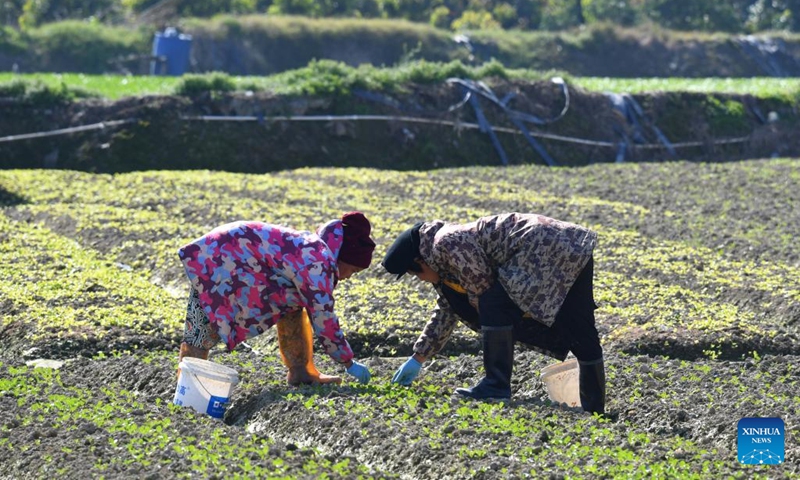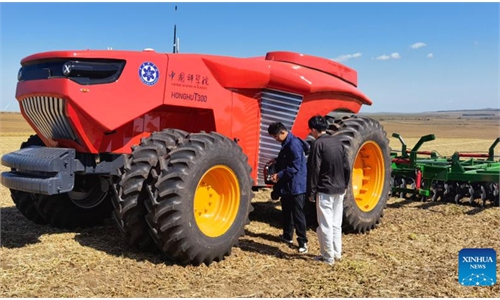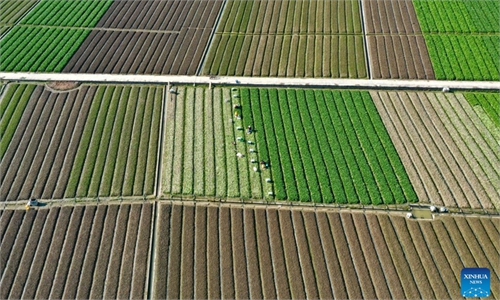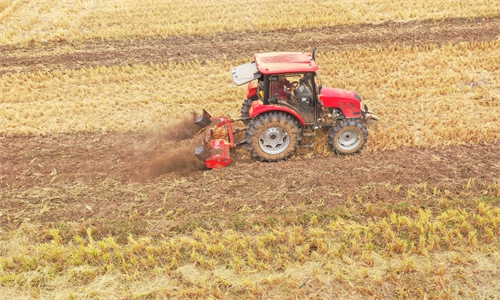
Farmers weeds in a field in Nantong Township of Minhou County, southeast China's Fujian Province, Jan. 30, 2023. Photo: Xinhua
Chinese authorities have vowed to ensure the supply of fertilizers and stabilize prices as the spring farming season gets underway. Spring farming is key to the full year's harvest, as part of the country's quest to secure people's "rice bowls" with mostly domestic grain.
Spring plowing and fertilizer preparations have entered a critical period, and preparatory work has moved gradually from the warm south to the cold north, the National Development and Reform Commission (NDRC), China's top economic planner, said in an article published on its WeChat account over the weekend.
Chemical fertilizers, which are directly related to the stability of spring farming, are highly significant in maintaining national food security.
The NDRC and 13 other national departments have issued a notice on ensuring fertilizer supply and stabilizing prices.
The notice asked local governments at all levels and relevant enterprises to take comprehensive steps to ensure the stability of the chemical fertilizer market during the spring plowing season.
Enterprises should implement a minimum production plan for 2023 and start an all-out production effort, while relevant parties should guarantee the supply of the factors of production such as coal, natural gas and sulfur, read the notice.
Circulation of chemical fertilizers should be improved, with timely shipments among enterprises and in areas where production is concentrated. Priority should be given to domestic chemical fertilizers and raw material transport via water and road, it added.
In Central China's Henan Province, with the wheat turning green, field management such as irrigation and pesticide-spraying is in progress. According to monitoring by the local agricultural authority, wheat sowing in the province is on time, and it's expected to achieve a stable harvest with higher quality.
Coupled with the implementation of pre-winter management measures, the seedling situation in the wintering period is the best year over the past five years, Chinanews.com reported.
Compared with the warm central and southern regions, Northeast China, a major agricultural region renowned for soybean planting, has not fully entered the spring farming time, but it is preparing actively.
Gai Yongfeng, head of the Jiaxing farm cooperative in Heihe, Northeast China's Heilongjiang Province, told the Global Times on Sunday that local spring farming has not started yet due to the cold weather, but preparations have been made including raw materials, machinery and personnel.
"We usually start plowing corn from April," said Gai, who's been planting corn and soybeans for several years.
Over the past three years, farmers worried about a lack of fertilizers, surging prices, labor shortages and the impact of COVID-19.
"I feel relieved that those problems have been fixed under the country's optimized COVID-19 measures. We have a smooth flow," Gai said, adding that loan support is also bolstering the preparedness of farmers.
He noted that the cooperative will consider expanding sowing areas after risk judgment.
In 2022, the managed area of Gai's cooperative reached 35,000 mu (2,333 hectares), including 25,000 mu of soybeans and 10,000 mu of corn.
Jiao Shanwei, editor-in-chief of industry news website cngrain.com, told the Global Times on Sunday that great importance has been attached to spring farming this year from the central government down to localities, as it is important for the full year's output and supply of major agricultural products.
"We should firmly grasp the initiative of food security by expanding output while relying less on imports and plan the annual grain production as soon as possible," Jiao said, noting that some changes are needed for the spring farming such as optimizing the sowing structure.
A bumper harvest of crops including wheat, soybeans and rapeseed in the summer could be secured this year though challenges have emerged such as rising production costs due to hefty fertilizer prices, Tang Renjian, director of the Central Rural Work Leading Group Office, also minister of agriculture and rural affairs, told a teleconference on bolstering preparedness for spring plowing on February 6.
He called for attaching the utmost importance to this year's food production, which will offer solid support for stabilizing prices and enhancing confidence in the country's economy.
In 2022, China secured a bumper harvest for the 19th year in a row amid the global food crisis, with its grain output at about 686.53 billion kilograms, up 0.5 percent from 2021, official data showed.
The hard-fought result was achieved despite delayed plantings, extreme weather and COVID-19 disruptions.
The country aims to expand output this year based on maintaining a level of more than 650 billion kilograms, while grain planting areas should be kept above 1.77 billion mu.




